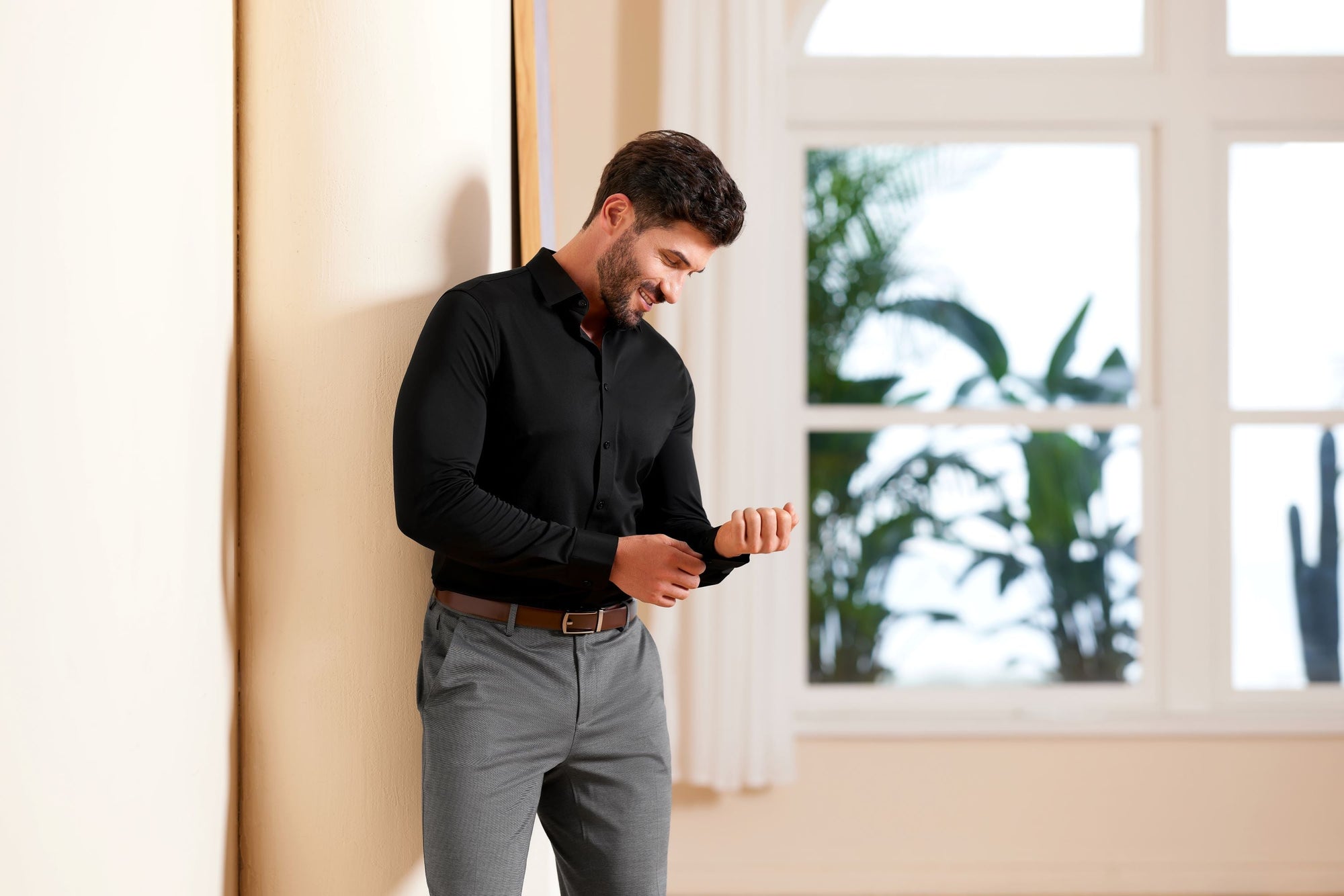You’ve picked the perfect dress shirt. The fit is sharp. The fabric? Immaculate. But one detail can still make or break the whole look: the collar.
Collars aren’t just an afterthought — they shape how your shirt frames your face, how your tie sits, and whether your outfit reads polished or confused. And yet, a lot of guys either ignore the collar completely or pick one based on whatever’s hanging at the store.
If that sounds familiar, don’t worry. This guide breaks down the three major collar types — spread, point, and cutaway — without the jargon or generic advice. We’ll keep it clear, practical, and just sharp enough to keep you from zoning out halfway through.
By the end of this, you’ll know exactly which collar style suits your face, your wardrobe, and your overall style without second-guessing it again.
Understanding Collar Anatomy (Because It Actually Matters)
Before we break down each style, it helps to know what we’re even talking about when we say “spread” or “point.” Here’s a quick collar anatomy cheat sheet:
-
Collar Points: The tips of the collar that frame your face and chest.
-
Spread: The distance between those two collar points.
-
Collar Band: The fabric strip that wraps around your neck and supports the collar.
-
Tie Space: That small gap between the collar points when the top button is closed.
These parts work together like a frame around a painting. Change one detail, and the whole vibe shifts. That’s why spread, point, and cutaway collars each give off a different impression — even if the rest of the shirt is the same.
Now let’s break them down.
The Spread Collar
This one’s the workhorse of modern dress shirts. Spread collars have a medium-to-wide distance between the collar points, typically anywhere from 4 to 6 inches apart. That wider spacing opens up the neck area a bit, which gives the collar a slightly more contemporary look.
Why it works:
-
Looks great with medium to large tie knots (like the Windsor).
-
Helps balance out narrower or longer face shapes.
-
Plays nicely with most suit lapels — especially wider ones.
The spread collar sits in a sweet spot: formal enough for the office, polished enough for events, and not so traditional that it feels stuffy. It’s what most guys should probably start with if they’re unsure.
When to wear it:
-
Business meetings
-
Dressy casual events (especially with the top button open)
-
Formal occasions where you want to look put-together but not uptight
Just keep in mind: if your face is rounder or wider, a spread collar can make it appear broader. So if that’s not the look you’re going for, maybe hold that thought.
The Point Collar
This is the most classic collar style — and probably what comes to mind when someone says “dress shirt.” The point collar has a narrow spread between the collar tips, usually around 1.5 to 3 inches. The points themselves are longer and angle downward more sharply than a spread collar.
It’s a more conservative look, and that’s not a bad thing. There’s a reason it’s been the go-to for decades.
Why it works:
-
Complements rounder or wider face shapes by drawing the eye downward.
-
Pairs best with slim or small tie knots like the Four-in-Hand.
-
Ideal for narrow suit lapels and more traditional tailoring.
Point collars do their best work in formal or professional environments where you don’t want your shirt calling too much attention to itself. They create a clean, vertical line that keeps things sharp and understated.
When to wear it:
-
Job interviews
-
Business formal dress codes
-
Settings where a traditional look is expected
Keep in mind: that narrow spread limits your tie options. If you’re someone who likes a full Windsor knot or more aggressive styling, the point collar won’t give you the space to pull it off.
The Cutaway Collar
If the point collar is old-school, the cutaway collar is its modern, fashion-forward cousin. The spread is dramatically wide — sometimes so much that the collar points angle back toward the shoulders. Some versions almost form a straight line across the neck.
This style makes a statement. It’s bold, intentional, and not trying to blend in.
Why it works:
-
Perfect for full or oversized tie knots like the Windsor or Half Windsor.
-
Leaves room for bold tie designs or even no tie at all.
-
Balances longer or more angular face shapes by adding visual width.
This isn’t your everyday collar — unless your everyday includes high-level meetings, luxury settings, or you’re just the type who doesn’t mind turning heads.
When to wear it:
-
Style-forward formal events
-
Business environments with a more European or modern edge
-
Anytime you want your shirt to pull its weight in the outfit
One thing to watch for: a cutaway collar with no tie can look off if the collar isn’t structured enough. A shirt like that needs to hold its shape all day.
Other Collar Types
Of course, while the spread, point, and cutaway dress shirt collars are the most common when it comes to choosing your typical men's dress shirt — there are others out there that you should be aware of.
For instance:
-
Wing collar: Reserved only for black bow ties. Very specific use case: makes you look like a waiter at a black tie event.
-
Soft point collar: Relaxed and unstructured, designed without stiff interfacing—best worn without a tie.
-
Button-down collar: Originally made for sport shirts, now a staple in business-casual wardrobes.
-
Band collar (or collarless): Minimalist and very fashion-forward.
When choosing a dress shirt for most formal occasions, you probably won’t be going with these collar types. However, button-down collars are becoming more popular in formal settings. In slightly more informal events, all of the above collar types besides the wing collar might be acceptable.
Choosing the Right Collar for Your Face Shape
Matching a collar to your face shape is less about fashion rules and more about balance. The collar frames your face, and if the proportions are off, it’ll throw everything else out of sync.
Here’s how to make it work:
-
Round or wide face: Go for point collars. The downward angle draws the eye vertically and slims the face.
-
Long or narrow face: Choose spread or cutaway collars. These widen the appearance of your face and bring balance.
-
Oval face: Lucky you. Almost any collar style works, so choose based on your outfit or tie preference.
There’s no need to get obsessive about millimeters, but it’s worth matching the angles of your collar to the structure of your face. It’s a simple move that makes a big difference in how your whole outfit comes together.
Collar Compatibility with Suit Lapels and Tie Knots
Collar style isn’t just about your face shape — it also has to play well with the rest of your outfit. When the collar, tie, and lapels are all in sync, the look feels seamless. When they’re not, something just feels... off.
Here’s how to keep the proportions working in your favor:
-
Spread collars pair well with medium to wide lapels and larger tie knots like the Windsor or Half Windsor.
-
Point collars work best with narrow lapels and slimmer ties. They’re made for the classic Four-in-Hand knot.
-
Cutaway collars are designed for wider lapels and statement tie knots — or going tieless altogether for a bold, open-collar look.
Think of it as visual harmony. You don’t want a huge Windsor knot stuffed into a narrow point collar, or a spread collar flopping around with a skinny tie. The scale of each piece should complement the others.
Maintenance and Care Tips
Collars tend to be the first part of a dress shirt to wear out or lose shape, so a little care goes a long way in keeping your shirts looking sharp.
Keep them in good shape with these tips:
-
Use collar stays. They prevent curling and help the collar hold its structure. Metal ones tend to last longer than plastic.
-
Hang shirts properly. Avoid wire hangers and go for something with shoulder support to keep the collar from creasing.
-
Avoid over-starching. A little starch can help maintain crispness, but too much breaks down the fabric over time.
-
Watch the wash. Always unbutton the collar before washing, and skip the high heat when drying. Better yet, air dry them flat if possible.
-
Store with care. For travel or storage, consider a collar guard or folding the collar loosely to avoid permanent creases.
If you’re investing in high-quality shirts like the brand new Supima cotton xShirt, treating the collar right keeps them looking better, longer — and avoids that telltale bacon-strip warping some shirts develop.
What You Need to Know About Dress Shirt Collars
The right collar doesn’t just sit on your shirt — it shapes your entire look. Whether you're after the timeless edge of a point collar, the modern balance of a spread, or the bold flair of a cutaway, understanding how each style plays with your face shape, suit, and tie will level up how you dress.
Get the collar wrong, and even the best shirt can fall flat. Get it right, and it pulls everything together without trying too hard. And that’s the kind of detail that separates just “dressed” from well-dressed.


